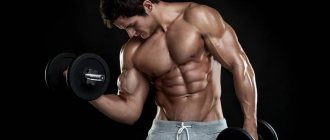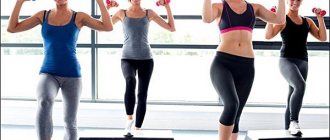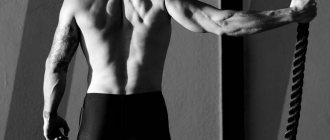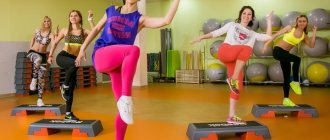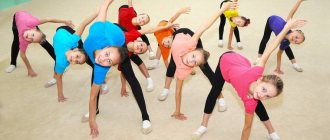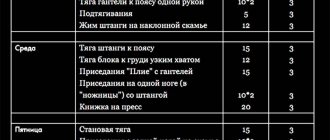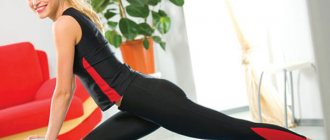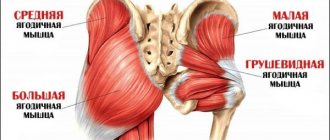Home workouts for men are a good way to keep your body in shape, lose extra pounds or, conversely, slightly increase muscle mass. Of course, you won’t be able to turn into a bodybuilder with impressive muscle size by working out at home. For such serious work, the gym needs appropriate equipment. But you can train and achieve good results without bulky sports equipment. After all, training at home is very effective if you approach the preparation of a training program correctly and, most importantly, do not be lazy.
Recommendations for training at home
The main condition for success in sports is self-discipline. Not the presence of a barbell, dumbbells or other sports equipment, but real male willpower. It's no secret that getting into a working mood in a cozy apartment, where every corner invites you to relax, is much more difficult than in the gym. Within the walls of the gym, everything is serious, the coach pushes you, other athletes motivate, you don’t even have to think about skidding.
But this does not mean that training at home is a disastrous idea. Not at all. The main thing is to set a goal and move towards it with confident steps. In addition, to achieve the desired results outside the gym, you need to listen to a number of tips from professional trainers.
Tip 1: Warm up
When creating a home workout program for men, it is important to understand that the lack of exercise equipment and the home environment do not exclude the possibility of injury. Moreover, if there was a significant break between classes and your muscles were unaccustomed to the load. You can’t neglect warming up, no matter how much you want to save time. Otherwise, you risk being out of action for a long time and temporarily forgetting about the perfect body you are striving for.
You should warm up correctly. Engage not only the muscle groups you are going to train, but also all the others. Start with slow movements and increase the intensity gradually. In the preparation process, you will need a detailed description of how to warm up before the main workout.
Tip 2: Stretching
When training at home, you should not forget about the cool-down. This final part of the class is no less important than the main part and warm-up. It is best to complete your workout with low-intensity exercise to bring your heart rate and blood pressure back to normal. They need to be done to help the body recover after heavy loads and gradually transition to a state of rest. In addition, moderate stretching promotes accelerated muscle growth.
Tip 3: Regularity
Only by exercising regularly can you get the desired results from your training. You need to train 3 times a week. Do not think that by reducing the number of classes, but increasing their intensity, you will achieve good results. Losing excess weight, a narrow waist and abs on the stomach will remain a pipe dream - no doubt about it. However, we should not forget to maintain balance.
Daily exhausting training will not make your body toned and your muscles sculpted. You will only drive yourself to exhaustion, but you will not achieve the desired results. After exercise, recovery time is needed. And lack of rest leads to the effect of overtraining (chronic fatigue, muscle spasms, depression).
Tip 4: distribution
When creating a training regimen, do not try to fit exercises for all muscles into one session. Each muscle group can be trained no more than 2 times a week. Between focused work with 1 group, sufficient rest is necessary. For example, on Monday you work the pectoral muscles, biceps and triceps, on Wednesday you actively use your legs, back, buttocks, etc. You can’t combine them; you’ll get exactly the opposite of the desired result.
If you exercise 3 times a week, the load on the first day should be 100%, on the second - 75%, on the third - 50%. How long it takes for full recovery depends on the athlete’s training. However, it is not recommended to load one muscle group more than 1-2 times weekly.
Tip 5: Nutrition
When choosing exercises at home for men, do not forget that only by combining regular exercise with proper nutrition can you achieve success. Anyone who exercises intensively in the gym or at home should have an idea of the principles of diet planning:
- Drink enough fluids. During physical activity, the body loses a lot of moisture.
- Reduce your consumption of fast carbohydrates. The diet should be low carbohydrate.
- Increase your protein intake from food (dairy products, nuts, meat).
- Don't increase your calorie intake by increasing portions. It's better to eat more often, but little by little.
- Take care of the fiber found in vegetables.
- Don't give up fat completely. Thus, seafood and vegetable oils are a source of healthy Omega-3 and Omega-6.
- Don't forget vitamin and mineral supplements.
We tell you in detail about how to eat during training to burn fat and maintain your figure.
Bodyweight training
There are a lot of exercises for this type of activity. Grabbing at everything is not a good idea. It is worth paying attention to the most effective ones.
Plank
A common exercise that allows you to load your back and abdominal muscles. From the outside it resembles the starting position for push-ups. To perform, you need to support your own weight, resting on the floor surface with your hands and toes (classic version). In addition to this, there is a bar on the elbows and a side bar.
Suitable for warming up. When performing, almost all muscle groups are involved. If you want to have a toned figure and a flat stomach, be sure to include this exercise in your training regimen. In this article you can familiarize yourself with the rules for performing the exercise.
Push ups
Allows you to train your upper body. The greatest load during exercise falls on the pectoral muscles, anterior deltoids and triceps. The neck and abs are strained less, but are also worked out well during push-ups.
To do a push-up, you need to take the starting position, keeping your weight on your outstretched arms and toes, and then lower yourself to the floor, spreading your elbows to the sides. While in the lower position, try to touch your chest to the surface of the floor. Then return to the starting position.
Pull-ups
This is a basic exercise that puts a good load on the back muscles. Performed in various ways:
- wide grip;
- narrow grip;
- reverse grip.
Using different execution options, you can adjust the load by alternately using different muscle groups.
Previously, we talked about how to do pull-ups correctly in our article.
Squats
Squats can be used to train your lower body. During classes, the muscles of the thighs and buttocks are loaded. The back and calf muscles are also involved, but a little weaker.
When starting the exercise, stand straight with your feet shoulder-width apart. Start squatting while simultaneously extending your arms forward or keeping them clasped across your chest. Return to the starting position.
To increase the load, squats can be performed with dumbbells or on one leg.
Crunches
Another common movement for working the abdominal muscles. In the classic variation, it is performed without weights. If you want to increase the load, you can use suitable sports equipment (dumbbells, medicine ball).
Twists are divided into several types:
- straight;
- reverse;
- double;
- lateral.
To perform the classic version, lie on the floor, bend your knees, cross your arms over your chest or place your palms behind your head. By tensing your abdominal muscles, lift your shoulders off the floor as much as possible. Lower yourself to the starting position.
Yoga
When it comes to yoga, it is important to understand that there is no division into male and female exercises, as such. However, there are asanas (postures) that can be classified as strength training. They are aimed at strengthening endurance and are perfect for representatives of the stronger sex.
These exercises include static ones, which involve staying in one position for at least 1 minute. Balance exercises, performed exclusively using the hands. Strengthening asanas that help build strength and endurance.
Before moving on to the main yoga exercises, it is necessary to prepare the body for stress using a set of dynamic asanas. Otherwise, you will not be able to complete more complex ones.
Strength training: more types than you think
Strength training in its purest form is the lot of athletes, powerlifters, and bodybuilders. But a competent combination of anaerobic exercise with coordination exercises, stretching, and cardio allows you to effectively burn fat, emphasizing the relief of the body. Depending on the proportion of strength exercises in the program, the intensity of their implementation, the number of repetitions, and the focus on different muscle groups, different types of training are formed.
THE BASE club has excellent conditions for training to develop strength. We have prepared for you fully equipped gyms, modern exercise equipment, experienced trainers and a large selection of workouts that turn sports into an exciting hobby.
Pay attention to these training options for developing strength.
GYM CLASS (Crossfit studio)
A worthy alternative to classic gym classes. It builds muscle mass and helps strengthen muscles and ligaments. Under the supervision of an experienced trainer and using free weights, already trained students can load their muscles more and more, achieving muscle hypertrophy and growth.
To learn more
GRIT STRENGTH (Les Mills Studio)
A program that combines anaerobic barbell exercises and high-speed plyometric exercises (jumping movements). This combination gives excellent results: increased endurance, muscle tone, active metabolism, rapid correction of body contour.
To learn more
TOTAL BODY STRENGTH (Exos studio)
Circuit training of basic anaerobic exercises to form a muscle corset. Includes work with free weights and additional accessories (for example, elastic bands). A balanced solution to develop whole-body strength, increase endurance, and improve coordination.
To learn more
STRENGTH & POWER (Exos studio)
A program for advanced athletes aimed at burning fat and gaining muscle mass. The first block of training includes exercises on special frames with a barbell, as well as basic exercises with free weights. Next comes aerobic exercise - circular and functional work for the development of the whole body and strength endurance.
To learn more
Training with free weights
Performing physical exercises for men with free weights involves the use of non-fixed exercise equipment. Such as dumbbells and barbells. Below we list the most common ones.
Dumbbell supine press
This option is especially good because the body is in a stable position when performing movements. This makes it possible to use heavy projectiles.
Lie on the floor, hold dumbbells above your chest area with your arms outstretched. Inhaling, lower them, bending your elbows. As you exhale, return to the starting position.
"Hammer" in a tilted position
This exercise allows you to engage the muscles of the upper and lower back.
To begin, take dumbbells and stand straight. Now lean forward with your knees slightly bent. Don't forget that your back should be straight when doing this.
In the starting position, the projectiles must be held on outstretched arms, so that the palms are turned towards each other. As you exhale, pull the weight to your chest and then gently lower it, exhaling.
Bent-over dumbbell raises
A very effective exercise that helps work the muscles of the upper back.
From a standing position, lean forward. Keep your back straight, do not round. With your elbows slightly bent, raise your arms with the apparatus to shoulder height. Try to stay in this position for a few seconds. Then return to the starting position.
Standing Dumbbell Raise
A classic movement that should be included in your training program without fail. With its help, you will be able to achieve good results quite quickly (pump up impressive biceps).
Stand up straight, arms with equipment extended along your body, palms facing away from you. Raise the dumbbells to the level of your upper sternum, bending your elbows. Don't swing while doing this.
Bench press
This exercise can be performed on a horizontal or inclined plane. Ideally, when thinking through a lesson plan, you should include both options.
Position yourself on a bench so that the bar is at eye level and grab the apparatus with a wide grip. Place your feet on the floor (do not lift your feet off the surface when doing this), bring your shoulder blades together.
Now remove the apparatus from the rack and, while inhaling, gently lower it, lightly touching the chest with the bar. As you exhale, return to the starting position.
Bent-over barbell row
Provides an opportunity to work the trapezius, rhomboid and broad back muscles. Also includes biceps and extensors.
Lean forward, bending your knees slightly. Grasp the bar with your palms, arms slightly wider than shoulder-width apart. As you exhale, pull the projectile towards your lower abdomen. Be sure to bring your shoulder blades together. As you inhale, return to the starting position.
When performing this exercise, the main load should be placed not on the arms, but on the shoulder blades and back.
French press
Suitable for athletes who want to increase the volume of their triceps.
Sit on a bench, having previously placed the apparatus so that it is convenient to reach it (or ask a gym buddy to help). Now grab the bar and lift the barbell in front of you at forehead level. Make sure your shoulders and elbows are straight.
Smoothly lower it behind your head as you inhale. As you exhale, return to the starting position.
Standing biceps curl
A very common and effective exercise with which you can pump up the biceps muscle. Performed in a standing or sitting position.
In this case, stand straight, do not bend your elbows and straighten your shoulders. Grab the bar and, while inhaling, pull the barbell toward your shoulder joints. As you exhale, lower your arms down. Don't bend your knees too much and round your back.
Scheme “Stronglifts 5×5”
This is a simplified version of the classic 5x5 pattern. It is simple, effective and does not require long periods of time in the gym. This program includes two workouts in total.
Workout "A":
- Barbell squats – 5x5;
- Bench press – 5x5;
- Bent-over barbell row – 1x5.
Workout "B":
- Barbell squats – 5x5;
- Standing barbell press – 5x5;
- Deadlift – 1x5.
Only 3 workouts per week. There should be at least one rest day between workouts. The training process is structured in the same way as in the “Starting Strength” program: in the first week we do workouts A, B and A, in the second - B, A and B.
How to properly warm up before training?
Start with two sets of 5 reps with an empty bar, whether you're doing squats, bench presses, or standing presses. Then add 10-20 kg and do 2-3 repetitions. Continue adding 10-20 kg at a time and doing 2-3 repetitions until you reach your working weight. Don't rest for long periods between warm-up sets to avoid stretching out your workout. For deadlifts and bent-over rows, do not do sets with an empty bar. Without discs, you will not be able to place the barbell on the floor; you will have to keep it in the air all the time.
Never start working on a 5x5 pattern without warming up. This will make the weight feel heavier than it actually is, you will do fewer reps, and you may get injured. Start with an empty bar so you get the hang of the technique.
Doing cardio before strength training will not be enough. This may work against you. Too much cardio before your workout will tire your legs and make it harder to squat with heavy weights.
How to increase working weight?
The principle of progression is simple: add 2.5 kilograms each time for each exercise. Yes, so in a week you will increase your squats by 7.5 kilograms. Beginners can do this quite well. For experienced athletes - impossible.
Rest time between sets
Rest 2-5 minutes between sets.
What to do if there is no progress?
If you can't complete the set number of repetitions, you need to take a step back.
Safety precautions when performing strength exercises at home
Thinking that when practicing at home you can forget about safety rules is a big mistake. It is imperative to follow them, regardless of where exactly the training takes place.
- Choose the right clothes and shoes. Things should not restrict movement and, on the contrary, be too free.
- Monitor your well-being. At the first sign of discomfort (dizziness, nausea, increased body temperature), stop training. It is better to postpone the activity than to get injured and end up in a hospital bed.
- Be sure to warm up before performing the main set of exercises.
- Make it a habit to check sports equipment before training for damage.
- Perform exercises only in the designated area. In the absence of interfering pieces of furniture, sharp corners, etc.
- Do not throw shells on the floor, place them carefully. If you don’t want to repair the coating, buy new equipment or receive treatment for injuries.
- After classes, be sure to put the sports equipment in its place. In comfortable apartments there is not enough free space to successfully maneuver between scattered dumbbells, weights and other equipment.
Do not forget that discipline and maintaining order are the first steps to obtaining decent results.
How else can you exercise at home?
In addition to training with your own weight or loose sports equipment, there are many effective exercises that involve the use of exercise machines. Of course, many immediately imagine bulky structures that require at least a separate room for installation. Don’t rush to conclusions, there are now many modern models that are ideal for practicing at home. And you won’t have to drag furniture to a neighboring apartment to free up space.
Which exercise machine is best to choose for exercising at home can be read in this article.
Healthy food delivery on the Grow Food promo codes .
Workouts for weight loss at home
The main goal of working out for weight loss at home is to lose more calories. The workout program presented below for losing weight at home is also suitable for those who want to keep their muscles toned.
- Jumping rope. Counting can be done in the number of jumps or by time. In the first case, do 5 approaches of 30, in the second - 3 approaches of 1 minute.
- Burpee. 15 x 3.
- Batmans. While standing, do 50 swings forward, sideways and backwards. Then repeat for the second leg.
- Boat. Do 3 sets of 50 seconds.
- Scissors. 3 sets of 50 leg crossings.
This complex can be supplemented with planks, push-ups, squats, lunges and other exercises from a home workout without equipment. If your physical fitness is not enough to complete the entire weight loss workout at home, reduce the number of approaches. And to increase the load in the exercises, use a fitness band and dumbbells.
To achieve results:
- do exercises regularly;
- eat right;
- eat less sugar, use honey as an alternative;
- create a calorie deficit;
- drink more water.
Working out at home for weight loss is similar to cardio and strength training. If your goal is to lose weight, then use any of the home workouts presented here.
And remember, if you choose to workout at home, no equipment is required. Many experts, such as Paul Wade, believe that a better figure can be achieved through bodyweight training.
